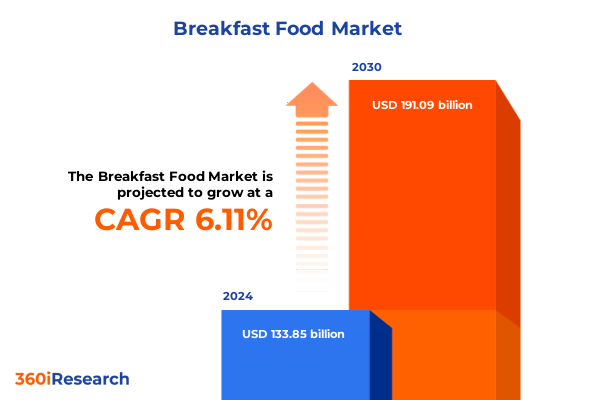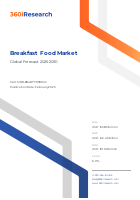The Breakfast Food Market size was estimated at USD 133.85 billion in 2024 and expected to reach USD 142.43 billion in 2025, at a CAGR 6.11% to reach USD 191.09 billion by 2030.

Introduction to the Evolving Breakfast Food Landscape
The breakfast food industry stands at a crossroads of evolving consumer demands, technological innovation, and shifting regulatory environments. Once dominated by traditional staples, today’s market reflects a dynamic interplay of health consciousness, convenience, and global flavor exploration. As competition intensifies, stakeholders must grasp both long-standing drivers and emerging disruptors to stay ahead. This executive summary distills critical insights across industry transformations, tariff implications, segmentation patterns, regional variances, and competitive dynamics. By weaving together these threads, decision-makers can chart informed strategies and capitalize on growth opportunities in an increasingly complex landscape.
Transformative Shifts Redefining the Breakfast Food Market
Over the past decade, three pivotal shifts have redefined the breakfast segment. First, a surge in health-driven innovation has propelled demand for high-protein bars, whole-grain cereals, and plant-based dairy alternatives, forcing established brands to overhaul product portfolios. Next, digital commerce and last-mile delivery platforms have accelerated on-the-go and single-serve formats, enabling direct-to-consumer models and subscription services. Meanwhile, consumer palates have expanded beyond classic sweet and savory flavors to embrace global tastes-spiced flatbreads, matcha-infused pastries, and nutrient-dense bowl meals. These transformative currents are converging to create an ecosystem where agility, data-driven personalization, and cross-category partnerships become essential for sustained growth.
Assessing the 2025 US Tariff Impact on Breakfast Food Supply Chain
In 2025, escalated tariff measures introduced new cost pressures along the supply chain, particularly affecting imported grains, packaging materials, and specialty ingredients. Manufacturers reliant on overseas suppliers have faced margin compression as duty rates rose on key inputs. This has driven a dual response: sourcing diversification toward domestic farmers and renegotiated trade agreements with alternative exporters. Retailers, in turn, have adapted pricing strategies to balance shelf competitiveness with profitability, leveraging private-label offerings and value-added packs. Ultimately, the tariff environment has accelerated supply-chain resilience initiatives, prompting investments in localized production, vertical integration, and real-time logistics optimization to cushion future policy shocks.
Key Segmentation Insights Shaping Consumer Choices and Innovation
Market segmentation reveals nuanced pathways to capture diverse consumer needs and innovation hotspots. By type of breakfast food, breads and pastries lead in convenience and premium positioning, driven by artisanal bagels and flaky croissants, while breakfast bars-both granola and protein varieties-thrive among active lifestyles. Cereals ranging from traditional cornflakes to fiber-rich oatmeal maintain breakfast routines, even as niche formats like high-protein granola gain traction. Dairy-based products, notably Greek yogurt and specialty cheeses, underpin the wellness focus, while egg-based dishes such as egg muffins offer portable protein. Meat segments, led by bacon and sausage, remain staples in certain demographics, and frozen pancakes and waffles continue to benefit from automated home-preparation trends.
Age-based insights highlight that adults prioritize nutritional balance and convenience, children respond strongly to branded characters and flavored formats, seniors value digestibility and fortified options, and teenagers seek indulgent twists and shareable formats. Packaging type segmentation demonstrates that bulk packages appeal to cost-conscious families, family packs support multi-person households, and single serve caters to on-the-go consumption. Dietary preference clusters underscore the rise of gluten-free breads and cereals, keto-friendly bars, certified organic lines, and vegan alternatives spanning dairy-free yogurts to plant-based sausage substitutes.
Distribution channels shape market reach: convenience stores excel at impulse purchasing for immediate consumption, online retail unlocks vast assortments with personalized delivery, specialty stores curate premium and ethnic offerings, and supermarkets and hypermarkets anchor both value and innovation. Meal-time segmentation-from brunch gatherings to family breakfasts and rapid on-the-go routines-pushes product developers to tailor textures, portion sizes, and preparation methods. Ingredient type preferences, including natural flavorings, refined sugar moderation, and whole-grain enrichment, directly influence product labeling and formulation. Lifestyle and health considerations such as high-protein claims and weight-management positioning drive NPD road maps. Finally, price-range tiers from economy through mid-range to premium enable brands to align value propositions with target consumer segments, ensuring broad market coverage while capturing margin uplifts where willing-to-pay is highest.
This comprehensive research report categorizes the Breakfast Food market into clearly defined segments, providing a detailed analysis of emerging trends and precise revenue forecasts to support strategic decision-making.
- Type Of Breakfast Food
- Consumer Age Group
- Packaging Type
- Dietary Preferences
- Distribution Channel
- Meal Time
- Ingredient Type
- Lifestyle And Health Consideration
- Price Range
Regional Variations Driving Market Dynamics Across Major Geographies
Regional dynamics further complicate strategic planning. In the Americas, mature markets blend heritage brands with agile newcomers, leveraging extensive retail infrastructures and digital ecosystems. Health and wellness trends dominate product development, with protein-rich and functional formulations achieving strong uptake in North America, while Latin American markets emphasize affordability and local flavors. In Europe, Middle East & Africa, the landscape is fragmented: Western Europe leads with gluten-free and organic variants, Northern Europe excels in sustainability certifications, and the Middle East & Africa region shows growing interest in fortified cereals and Halal-certified alternatives. Asia-Pacific, the fastest-growing region, is characterized by shifting consumer lifestyles, rising disposable incomes, and expanding e-commerce penetration. Traditional rice-based breakfasts are increasingly complemented by Western-style cereals and portable bakery items, with premiumization accelerating for imported and fusion products.
This comprehensive research report examines key regions that drive the evolution of the Breakfast Food market, offering deep insights into regional trends, growth factors, and industry developments that are influencing market performance.
- Americas
- Asia-Pacific
- Europe, Middle East & Africa
Competitive Landscape: Leading Companies Steering the Breakfast Food Industry
The competitive landscape is marked by both established conglomerates and agile specialist players. Global giants like Nestlé S.A. and Kellogg Company leverage extensive R&D capabilities to introduce functional and plant-based ranges, while PepsiCo, Inc. and General Mills Inc. capitalize on brand equity and distribution strength. Unilever Limited and Mars, Incorporated extend snack-inspired formats into breakfast occasions. At the same time, The Kraft Heinz Company and B&G Foods, Inc. reinforce private-label partnerships to offer value propositions in supermarkets and discount retailers.
Specialty manufacturers such as Bob’s Red Mill Natural Foods, Inc. and Nature’s Path Foods, Inc. have secured loyal consumer bases through clean-label commitments, while Alara Wholefoods Ltd. and Britannia Industries Limited lead regional innovation in value-driven markets. Emerging players like Bagrrys India Limited and Marico Limited. tap into local heritage, introducing culturally resonant breakfast solutions. Upstream integration strategies by Campbell Soup Company and Conagra Brands, Inc. aim to streamline supply chains, while Del Monte Fresh Produce Company and Trillium Farm Holdings, LLC explore vertical models for fresh and frozen segments. Technology-enabled startups focused on personalized meal kits and subscription breakfast services also challenge traditional models, forcing incumbents to reimagine omnichannel engagement.
This comprehensive research report delivers an in-depth overview of the principal market players in the Breakfast Food market, evaluating their market share, strategic initiatives, and competitive positioning to illuminate the factors shaping the competitive landscape.
- Alara Wholefoods Ltd.
- B&G Foods, Inc.
- Bagrrys India Limited
- Bob's Red Mill Natural Foods, Inc.
- Britannia Industries Limited
- Campbell Soup Company
- Conagra Brands, Inc.
- Del Monte Fresh Produce Company
- General Mills Inc.
- Happy Egg Co.
- Hormel Foods Corporation
- ITC Limited
- Kellogg Company
- Marico Limited.
- Mars, Incorporated
- McVitie's (The United Biscuits Private Limited)
- Nature’s Path Foods, Inc.
- Nestlé S.A.
- Oetker Group
- PepsiCo, Inc.
- Starbucks Corporation
- The Hain Celestial Group
- The Kraft Heinz Company
- Trillium Farm Holdings, LLC
- Unilever Limited
Actionable Recommendations for Industry Leaders to Capitalize on Emerging Trends
To translate these insights into tangible gains, industry leaders should consider the following best practices:
- Enhance Supply-Chain Agility: Foster partnerships with a diversified network of ingredient suppliers and invest in near-shoring to reduce tariff exposure and lead times.
- Accelerate Health-Forward Innovation: Prioritize R&D in protein enrichment, gut-health ingredients, and plant-based formulations, leveraging consumer data analytics for targeted product launches.
- Optimize Omnichannel Distribution: Integrate e-commerce platforms with brick-and-mortar operations, employing dynamic pricing and personalized promotions to drive repeat purchases.
- Refine Segmentation Strategies: Align SKU portfolios with key demographics by offering tailored formats-single-serve for on-the-go consumers, family packs for households, and premium lines for discretionary spenders.
- Localize Regional Offerings: Adapt flavor profiles, packaging designs, and certification claims to resonate with distinct market preferences across the Americas, EMEA, and Asia-Pacific.
- Reinforce Sustainability Credentials: Commit to transparent sourcing, minimal processing, and eco-friendly packaging to meet rising consumer expectations and regulatory standards.
- Leverage Strategic Collaborations: Explore co-branding, private-label partnerships, and digital alliances to expand market reach and share development costs.
Explore AI-driven insights for the Breakfast Food market with ResearchAI on our online platform, providing deeper, data-backed market analysis.
Ask ResearchAI anything
World's First Innovative Al for Market Research
Conclusion: Navigating the Future of the Breakfast Food Market
The breakfast food sector’s trajectory will be shaped by the intersection of health imperatives, digital transformation, and evolving consumer lifestyles. Stakeholders who proactively embrace data-driven innovation, fortify supply-chain resilience, and localize offerings will unlock new growth avenues. By balancing cost efficiencies with premiumization strategies, companies can navigate tariff fluctuations and competitive pressures while meeting consumer demands for convenience and wellness. Ultimately, a holistic approach that integrates segmentation, regional adaptation, and sustainability will define market leadership in the years ahead.
This section provides a structured overview of the report, outlining key chapters and topics covered for easy reference in our Breakfast Food market comprehensive research report.
- Preface
- Research Methodology
- Executive Summary
- Market Overview
- Market Dynamics
- Market Insights
- Cumulative Impact of United States Tariffs 2025
- Breakfast Food Market, by Type Of Breakfast Food
- Breakfast Food Market, by Consumer Age Group
- Breakfast Food Market, by Packaging Type
- Breakfast Food Market, by Dietary Preferences
- Breakfast Food Market, by Distribution Channel
- Breakfast Food Market, by Meal Time
- Breakfast Food Market, by Ingredient Type
- Breakfast Food Market, by Lifestyle And Health Consideration
- Breakfast Food Market, by Price Range
- Americas Breakfast Food Market
- Asia-Pacific Breakfast Food Market
- Europe, Middle East & Africa Breakfast Food Market
- Competitive Landscape
- ResearchAI
- ResearchStatistics
- ResearchContacts
- ResearchArticles
- Appendix
- List of Figures [Total: 34]
- List of Tables [Total: 820 ]
Call to Action: Engage with Ketan Rohom for In-Depth Market Intelligence
To access the full breadth of insights, detailed analysis, and strategic frameworks presented in this report, contact Ketan Rohom, Associate Director, Sales & Marketing. Secure your copy today to empower your team with the data and guidance needed to stay ahead in the dynamic breakfast food landscape.

- How big is the Breakfast Food Market?
- What is the Breakfast Food Market growth?
- When do I get the report?
- In what format does this report get delivered to me?
- How long has 360iResearch been around?
- What if I have a question about your reports?
- Can I share this report with my team?
- Can I use your research in my presentation?




